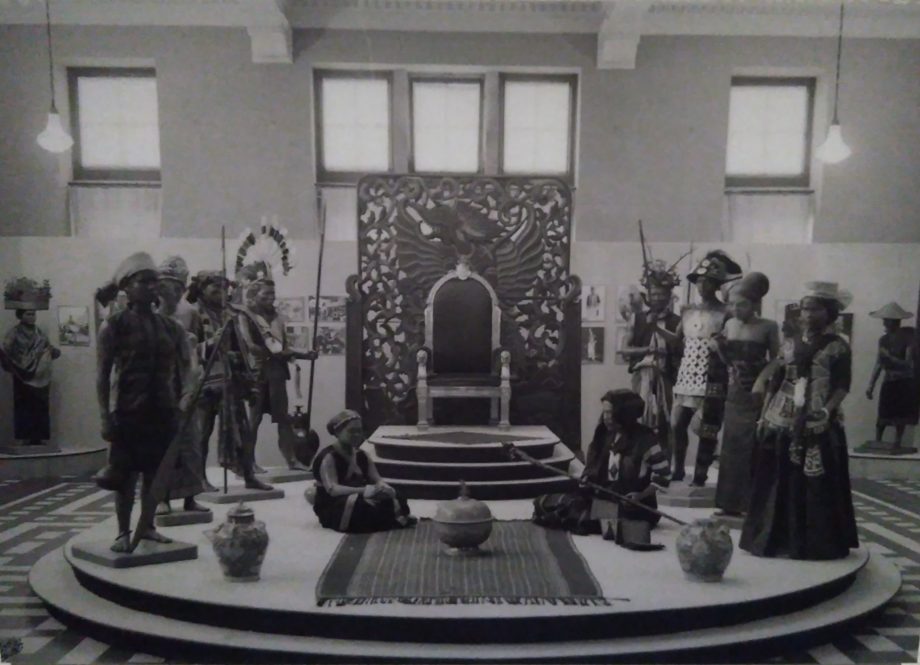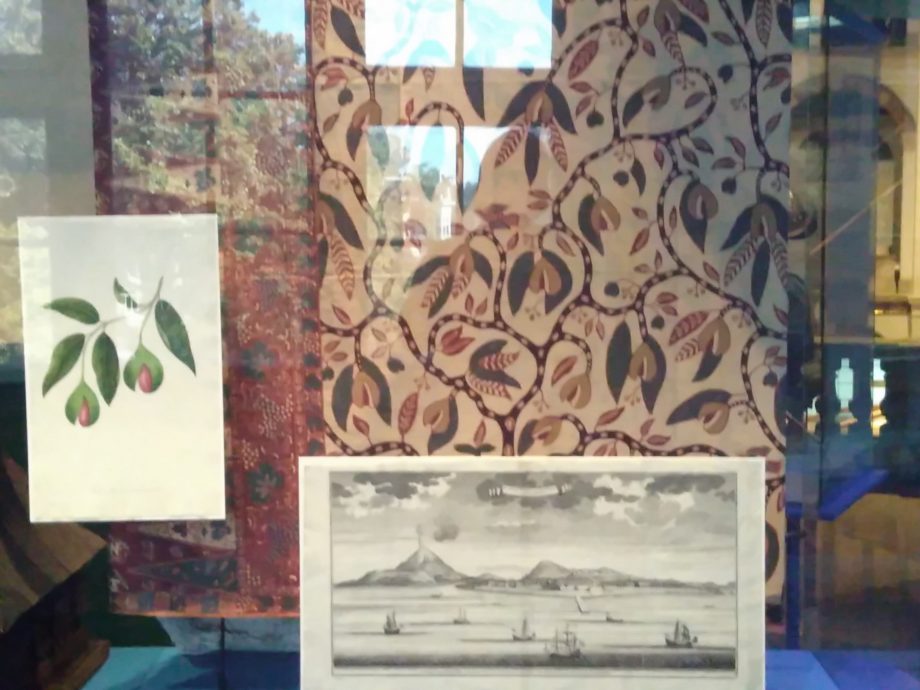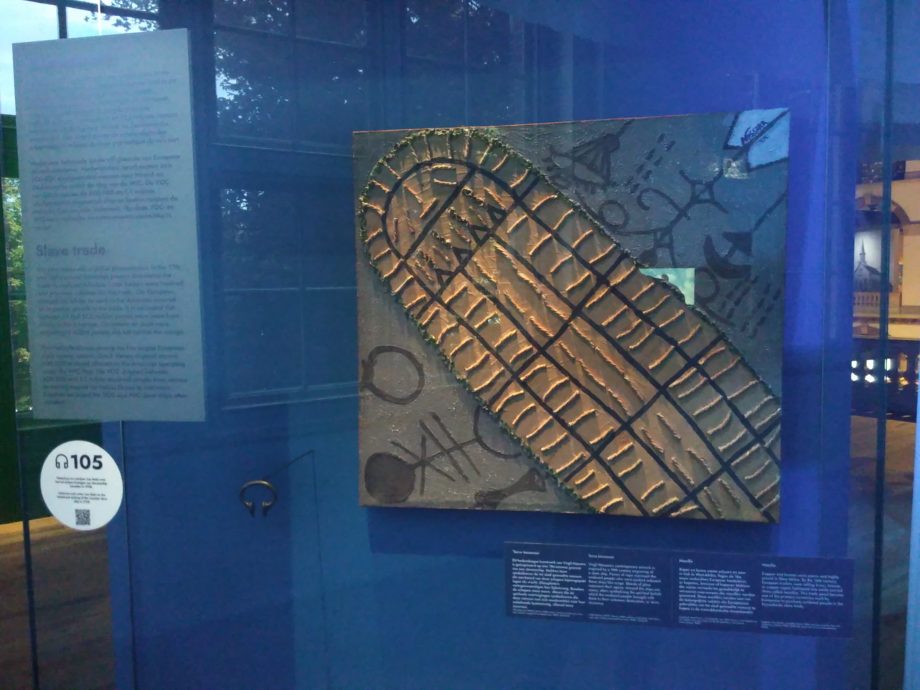„Our Colonial Heritage”
An Exhibition Review of the Tropenmuseum´s New Permanent Exhibition
Entering the Tropenmuseum always fills me with a mixed feeling of awe and discomfort. The grandiose imperial architecture of its central hall has lost nothing of its power to instil these emotions in the visitor coming face to face with what was once the Koloniaal Museum of the Dutch Empire. Since then, the museum’s contents and mission have been reinvented several times, and the most recent of these innovations has now opened to the public: the new permanent exhibition “Our Colonial Heritage”. Under the directorship of Content Director Wayne Modest, the museum had been preparing for this step for several years, with research, public discussions, and smaller exhibitions such as “Afterlives of Slavery” in 2017.[1] Now, all the experiences gathered in these years of preparation have come together to form the museum’s new permanent exhibition. It takes up almost the entire first floor of the building and that means that it is big, around 1200 m². A visitor like me who tries to take in all the information will soon notice that the museum’s closing hour is approaching fast while they have not even seen half of the material on display. The size means that the curators could address a broad variety of topics, ranging from specific national colonial histories to slavery, racism, language, and religion. The size matters because it makes an important statement: here is a museum that takes imperial history and its many manifestations in the present truly seriously. The knowledge that all these galleries are there to stay for at least seven years, that they are not a momentary response under outside pressure to get it over with but a permanent site for learning about and debating our colonial heritage, made me feel almost exhilarated. The exhibition is far from perfect, and I will address its weaknesses in a moment, but in the grand scheme of things the fact that it exists is, to me, simply marvellous.
The exhibition begins with a two-screen video installation showing interviews, speeches, and performance art addressing the Dutch colonial heritage. When I entered, the first thing I saw was Amsterdam’s mayor Femke Halsema offering her apologies for Amsterdam’s role in the Dutch slave trade. The apology was surprisingly moving and sincere and hence, for me, set the tone for the whole exhibition, which, in its efforts to address imperialism without euphemism, felt equally sincere.[2] Imperial violence and the effects it continues to have on peoples’ lives are present in all parts of the exhibition and they are addressed in plain and concrete language. Importantly, they are not only named by artists and activists but in the curatorial text itself. Slavery, genocide, racism – the curators call violent acts by their name and make clear that the Dutch nation bears responsibility for them. Take, for example, the following text addressing the Dutch genocide on the Indonesian island Banda:
The most notorious genocide in Dutch colonial history is the massacre of fourteen thousand inhabitants of Banda Island in 1621 by a VOC army. Jan Pieterszoon Coen gave the order after the Bandanese refused to accept a Dutch monopoly on the nutmeg trade. Of the approximately one thousand people who survived, some were sent by Coen into slavery on Java. They were later sent back to Banda to work on the nutmeg orchards in a form of plantation slavery.
This straight-forward style of addressing Dutch colonial violence reappears if not in all then in most of the exhibition’s texts. Maybe I should not have been surprised, given the museum’s expertise when it comes to the power of language[3], but somehow I still was: in the end, it is one thing to address racism and colonial language in an online publication and quite another to do so in the actual texts of a permanent exhibition.
And the museum does not spare itself from this scrutiny. A small but dense section is dedicated to the imperial legacy of the institution itself: “Originally committed to an idea that some population groups had progressed further in their development than other groups, these [ethnographic] museums reinforced racial and colonial ideology.” While the text does not go much deeper in explaining how this happened, the photographs displayed next to it give a pretty good idea. Presented right next to the balustrade overlooking the main hall, the visitor encounters images of a throne the former colonial museum had erected in that very hall for Queen Wilhelmina, surrounded by wax figures representing colonial populations rendering homage to the imperial monarch. The striking visuals of this symbol of imperial power at the heart of the museum shows its true ideological purpose better than any text could.[4] The section is completed by artist Heri Dono’s installation “The Museum of Ethnography”, a series of miniature dioramas showing disturbing arrangements of dolls and other figurines. The boxes are illuminated suddenly upon the visitor’s approach, making the ethnographic museum seem almost like a set from a horror movie. Taken together, the text, photographs and artwork convey the museum’s imperial legacy not only intellectually but also on an emotional level, leaving the visitor with an almost visceral feeling of discomfort.

Picture 1: Photograph showing the Wilhelmina’s throne at the Koloniaal Museum
Unfortunately, this interaction of different mediums does not always work as successfully. Take, for example, the display case on the Banda Genocide mentioned above. While the text is clear in its content and goal, the choice of objects is not. Next to the text, the visitor finds a botanical drawing of a nutmeg fruit, cloth with a nutmeg-inspired batik pattern and a Dutch etching showing the island of Banda. On the other side of the display case stand a model of a ship and a house made of cloves, a bust of Jan Pieterszoon Coen and a schoolbook illustration of a peaceful plantation. Granted, all these objects have some link to the spice trade and hence to the Banda genocide. But none of them seem to provide any additional information, nor do they offer ways to approach the genocide emotionally. To me, it feels like the curators wanted to address Banda and then just added some stuff they found in the museum’s collection that could somehow be connected to the topic. But instead of expanding the meaning of the text, this clutter of objects distracts from it. I think that placing a novelty boat model next to a text about genocide cannot but trivialise the deliberate murder of an entire island’s population.

Picture 2: The Banda Genocide display case
This mismatch repeats itself in several places throughout the exhibition. I often asked myself: why am I being shown this particular object? What does it add to the subject at hand? On the one hand, this is a specific curatorial problem and I think the carelessness of the Banda case indicates that the emotional scope of such imperial violence is still underestimated, even in an exhibition so explicitly dedicated to it. On the other hand, the case points to a deeper-lying problem concerning the ethnographic museum as an imperial archive: there simply might have been no better objects to display the genocide, because, within the imperial archival logic, there was no reason to preserve them. Of course, the archive is not a monolithic entity and there are sometimes objects that slip through the cracks and today offer opportunities to materialise violence and resistance. But in most cases, nothing remains but the nostalgic bric-a-brac that can be found in the display case. So, inadvertently, the Banda case raises an important question: what could be the role of such objects as museums like the Tropenmuseum continue their decolonisation process?
An increasingly common strategy to counter the problem of lacking material is the use of contemporary artworks. And the section on the museum’s history, among others, shows that this can work very well. But “Our Colonial Heritage” also demonstrates that art is not a universal solution for such problems of representation either. Throughout the exhibition, artworks are often the only visual depiction of imperial violence. This is due to the curators’ decision not to use archival material showing graphic violence.[5] This probably was a conscious decision that does have its merits: the visual victimisation of People of Colour is not repeated, and the exhibition remains accessible for audiences of all ages. But it also places a lot of responsibility on the artworks that are, after all, a highly subjective medium usually not aimed at functionality. Take, for example, Virgil Nassara’s abstract depiction of a slave ship: its abstraction represents an interesting approach, but because it is the only depiction of the violence abord these slave ships it ends up feeling rather vague and a bit trivialising. In other cases, such as the Banda genocide, there is neither an artwork nor archival material depicting the violence, leaving the visitor only with the visuals of the propagandistic etching and schoolbook illustration. I would argue that if artworks become central pieces in an exhibition’s narrative, they might ‘collapse’ under the pressure to convey specific meanings.

Picture 3: Virgil Nassara’s abstract artwork “Terra Inconnue” showing a slave ship
The combination of these issues had, for me, an unsettling effect. While all the information was there, comprehensive and presented in earnest, the exhibition at times felt lifeless to me, failing to convey any kind of emotion. The violence that was addressed in the curatorial text seemed abstract and elusive and the objects that could have created a connection instead stood in the way of a more thorough engagement. This made the exhibition’s wealth of material feel almost encyclopaedic, raising point after point without giving them the (emotional) depth they require. The unnamed curatorial voice was speaking from everywhere and nowhere, and while what it said was true, its way of speaking still felt wrong.
This feeling changed when I finally got around to listening to the audio guide. Because the guide required a smartphone with headphones, which I did not bring, I could only listen to the short interviews later after I had already left the exhibition. I think my experience would have been different had I been able to listen to them before because suddenly there they were: engaging and emotional stories and perspectives that conveyed some of the extent to which imperialism had impacted and continues to impact people’s lives. Yet these perspectives are hidden behind the relatively high barriers of visitors owning and bringing specific technology. Alternatively, visitors can listen to all content in the museum, but outside the exhibition. Moreover, most audios are only available in Dutch. The combination of these barriers will lead to many visitors leaving the exhibition without ever listening to one of these important voices – an oversight that, in my opinion, needs to be corrected for the exhibition to work.
Finally, among all the issues that were addressed, one felt strangely absent to me: the sexualisation and sexual violence so central to all forms of imperial domination. The topic does appear here and there, in a sentence or two. In the section on race and racism, the visitor learns that “it was generally prohibited, for example, for colonizers to be in an intimate relationship with someone who was enslaved or with a colonised person.” In the section on slavery, the text states that “these enslaved workers were often victims of physical and sexual abuse.” And, towards the end, present-day descendants of the colonised learn what they “may well prefer not to know: that they descend from an enslaved woman, or from a nyai [a housekeeper-concubine].” All these fragments, bubbling up across the exhibition, seem to indicate that there was indeed something that would have deserved to be addressed but could still not be displayed in a proper framework. While Ann Stoler, who was among the first scholars to bring attention to the importance of sexuality for imperial rule, is already cautioning against a simplistic and inflationary use of the subject in academic discourses,[6] there still seems to be no curatorial strategy for displaying the intimate politics of empire to a wider audience.
All these points of critique, however, should not distract from the fundamental achievements of the exhibition. Especially in comparison with the other recently opened permanent exhibition at the Humboldt Forum, “Our Colonial Heritage” feels like the future of what ethnographic museums could look like. The Tropenmuseum is setting new standards and hence it is little surprising that there will still be things going wrong and concepts not working out perfectly. But the fact that there seems to be a will to accept these challenges in earnest gives cause for hope. The exhibition will not go anywhere, it will stay and continue to attract debate and maybe also controversy. But this is exactly what makes it such a powerful tool for decolonization. To me, despite my critique, “Our Colonial Heritage” did not feel like an end – it felt like a beginning.
Footnotes
[1] For the difficulties of this process, see Caradonna, Vittoria. “‘All the Things Happening Outside of the Museum Push Me Back in’: Thinking through Memory and Belonging in Amsterdam’s Tropenmuseum.” International Journal of Heritage Studies 28, no. 1 (2022): 59–73. https://doi.org/10.1080/13527258.2021.1910064.
[2] Later, I wondered how I would have approached the displays that followed the initial screens if I had first seen Willem-Alexander’s blundered mess of an apology for the Dutch violence in Indonesia.
[3] See their online publication Words Matter.
[4] It also makes clear why the idea of using wax figures to display Dutch colonial history, as the previous permanent exhibition had attempted, seems rather strange, to say the least.
[5] An exception are the images of destroyed nature and landscapes in the section “Wealth from Overseas”. Those harrowing images work very well, making the gallery one of the most impactful of the exhibition.
[6]Stoler, Ann Laura. Duress: Imperial Durabilities in Our Times. Durham/London: Duke University Press, 2016.































